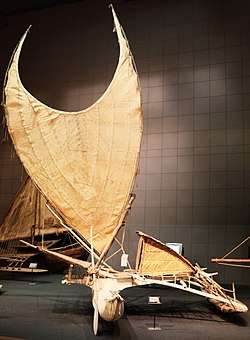Tepukei

A tepukei (from Te Puke, meaning an ocean-going canoe) is a very old Melanesian and Polynesian boat type, produced primarily by the Polynesian-speaking inhabitants of Taumako (Duff Islands). It was first reported in print by Spanish explorer Álvaro de Mendaña in 1595, on his visit to the Santa Cruz Islands.
A tepukei looks like an outrigger canoe with a crab claw sail, and is in fact a very sophisticated ocean-going sailing ship, belonging to the proa (two hulls of different size) type. Its main differences from other proas are:
- The main hull (vaka) has an almost circular section whose submerged profile remains constant despite heeling, and has a minimum of wet surface when heavily loaded.
- The vaka's top is very close to the flotation line, so it is closed with planks and the accommodations for the crew are on an elevated platform over the akas (the beams connecting the main hull and the smaller, windward hull).
In common with a typical proa, it uses a crab claw sail, one of the most efficient sail types known.
W. C. O'Ferrall, an Anglican missionary to Melanesia between 1897 and 1904, described the tepukei as a "sailing canoe". He described it as consisting of a dugout log equipped with a deck upon which a small hut was built, powered by a "lofty and strikingly shaped sail", and steered with a long paddle. He reported that men from Santa Cruz used the boat to travel as far away as the Solomon Islands.[1]
The Maunga Nefe, which may be the only surviving original tepukei, is in the Ethnological Museum of Berlin. It was brought by Dr. Gerd Koch from the Santa Cruz Islands in 1967.[2]
In recent years, tepukeis have been experiencing a renaissance. The Vaka Taumako Project has revived the traditional construction of these boats, and some are even being built in San Francisco.[3]
 Sail plan of a tepukei, drawn from the Maunga Nefe and the Vaka Taumako Project. Shows asymmetrical double hull, sail, and windward and leeward booms.[4] Does not show ropes.
Sail plan of a tepukei, drawn from the Maunga Nefe and the Vaka Taumako Project. Shows asymmetrical double hull, sail, and windward and leeward booms.[4] Does not show ropes. Stern view of the Maunga Nefe. Use red/blue 3-D glasses to see this image stereoscopically.
Stern view of the Maunga Nefe. Use red/blue 3-D glasses to see this image stereoscopically.- Stern view similar to the full-colour image above.
- Deck area of the Maunga Nefe.
- Side view of sail, with turbulence-reducing "ornaments".
External links
| Wikimedia Commons has media related to Maunga Nefe (boat). |
References
- ↑ O'Ferrall, Rev. W.C. (1908). Santa Cruz and the Reef Islands. Westminster: The Melanesian Mission.
- ↑ Koch, Gerd (1971). Die Materielle Kultur der Santa Cruz-Inseln (in German). Berlin: Museum fur Volkerkunde Ethnological Museum of Berlin.
- ↑ David O. Coy "PICA Canoe Project" Check
|url=value (help). Retrieved 13 March 2014. - ↑ http://vaka.org/2017/01/calling-the-wind-of-reunion/